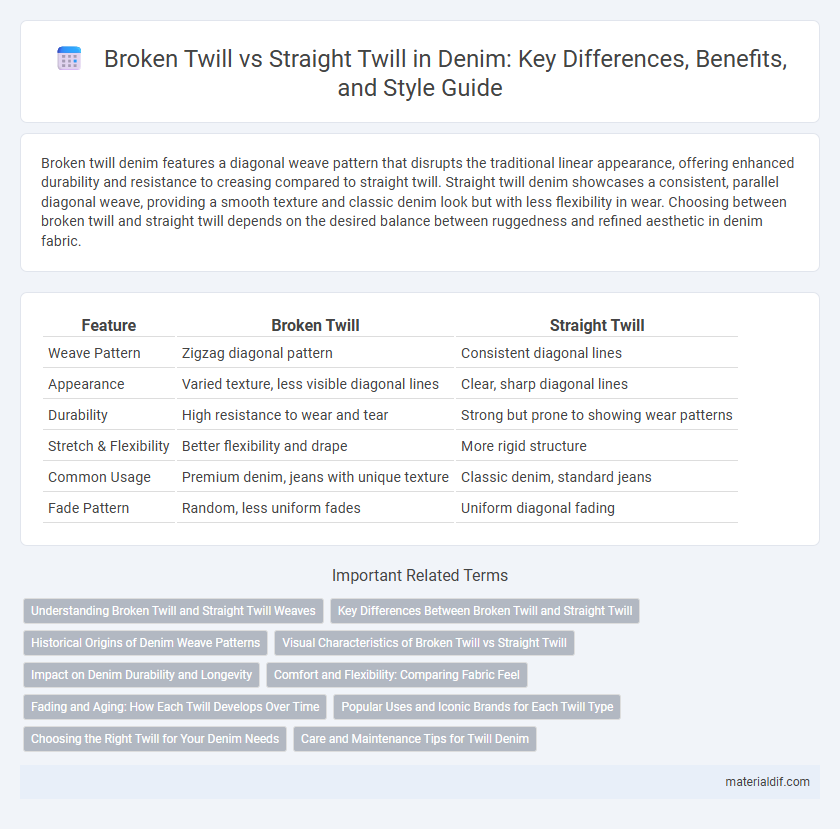Broken twill denim features a diagonal weave pattern that disrupts the traditional linear appearance, offering enhanced durability and resistance to creasing compared to straight twill. Straight twill denim showcases a consistent, parallel diagonal weave, providing a smooth texture and classic denim look but with less flexibility in wear. Choosing between broken twill and straight twill depends on the desired balance between ruggedness and refined aesthetic in denim fabric.
Table of Comparison
| Feature | Broken Twill | Straight Twill |
|---|---|---|
| Weave Pattern | Zigzag diagonal pattern | Consistent diagonal lines |
| Appearance | Varied texture, less visible diagonal lines | Clear, sharp diagonal lines |
| Durability | High resistance to wear and tear | Strong but prone to showing wear patterns |
| Stretch & Flexibility | Better flexibility and drape | More rigid structure |
| Common Usage | Premium denim, jeans with unique texture | Classic denim, standard jeans |
| Fade Pattern | Random, less uniform fades | Uniform diagonal fading |
Understanding Broken Twill and Straight Twill Weaves
Broken twill and straight twill weaves differ primarily in the direction and pattern of their diagonal lines, affecting denim's texture and durability. Straight twill features consistent diagonal lines running in one direction, creating a smooth surface with notable strength, while broken twill alternates the weave direction to produce a zigzag pattern that reduces fabric creasing and increases wrinkle resistance. The choice between broken twill and straight twill impacts denim's aesthetic appeal and performance characteristics, influencing garment longevity and wear comfort.
Key Differences Between Broken Twill and Straight Twill
Broken twill denim features a zigzag pattern that reduces visible diagonal lines, resulting in a softer texture and less pronounced wear marks compared to straight twill. Straight twill denim displays a consistent diagonal weave running in one direction, offering a classic look with clearer fading lines and greater fabric strength. The unique weave patterns directly impact the durability, appearance, and aging characteristics of denim garments.
Historical Origins of Denim Weave Patterns
Broken twill and straight twill are two fundamental denim weave patterns with distinct historical origins. Straight twill, the traditional weave, originated in the 19th century, characterized by its diagonal rib running uniformly down the fabric, widely used by Levi Strauss in the original blue jeans. Broken twill, developed later in the 20th century, features a reversed diagonal pattern that reduces the visible weave lines, strengthening the fabric and creating a softer, more textured denim.
Visual Characteristics of Broken Twill vs Straight Twill
Broken twill denim features a zigzag pattern with diagonal lines that alternate direction, creating a textured and less uniform appearance compared to straight twill. Straight twill denim displays parallel diagonal lines running consistently in one direction, giving it a cleaner, more classic look. The visual distinction between broken twill and straight twill enhances the overall aesthetic, with broken twill offering increased durability and resistance to visible wear.
Impact on Denim Durability and Longevity
Broken twill denim features a zigzag weave pattern that reduces the diagonal lines commonly found in straight twill, enhancing fabric strength and minimizing wear marks from repeated use. Straight twill denim, characterized by parallel diagonal lines, offers a classic look but may show fading and whiskering more prominently over time. The broken twill weave's structural durability often results in longer-lasting denim with less visible distressing, making it ideal for consumers seeking longevity and rugged wear resistance.
Comfort and Flexibility: Comparing Fabric Feel
Broken twill denim offers enhanced comfort due to its softer, more flexible weave that allows greater stretch and breathability compared to straight twill. Straight twill denim features a tighter, uniform weave that provides durability but tends to feel stiffer and less flexible during wear. The unique diagonal pattern in broken twill creates a more pliable fabric ideal for movement, making it a preferred choice for comfort-focused denim garments.
Fading and Aging: How Each Twill Develops Over Time
Broken twill denim features a diagonal pattern that disrupts fading lines, resulting in a more uniform and subtle aging process compared to the sharp, linear fades of straight twill denim. Over time, straight twill denim develops prominent high-contrast wear patterns along its parallel ridges, accentuating creases and folds. The irregular weave of broken twill softens wear marks, creating a durable fabric with less pronounced fading that appeals to those seeking a vintage look without stark contrast.
Popular Uses and Iconic Brands for Each Twill Type
Broken twill denim, known for its diagonal rib pattern, is popular among brands like Levi's and Nudie Jeans, favored for its softer feel and resistance to crease lines in casual wear. Straight twill denim, characterized by parallel and uniform diagonal lines, is widely used by iconic brands such as Wrangler and Lee, prized for its durability and sharp appearance in workwear and classic jeans. Each twill type influences garment longevity and aesthetic, with broken twill often chosen for vintage-inspired styles and straight twill for rugged, long-lasting denim products.
Choosing the Right Twill for Your Denim Needs
Broken twill denim features a diagonal pattern that reduces the fabric's tendency to crease and fade unevenly, making it ideal for those seeking durability and unique wear patterns. Straight twill denim offers a classic diagonal line that delivers a smooth, traditional look and consistent fade, perfect for a timeless, polished appearance. Choosing between broken and straight twill depends on whether you prefer longevity with distinctive aging or a clean, conventional style for your denim wardrobe.
Care and Maintenance Tips for Twill Denim
Broken twill denim requires gentler care compared to straight twill due to its distinct diagonal weave, which can be more prone to fraying and wear. Washing inside out in cold water preserves the fabric's texture and reduces fading for both types, while air drying is recommended to maintain the integrity of the twill pattern. Avoid harsh detergents and excessive agitation to extend the longevity of broken twill and straight twill denim.
Broken Twill vs Straight Twill Infographic

 materialdif.com
materialdif.com